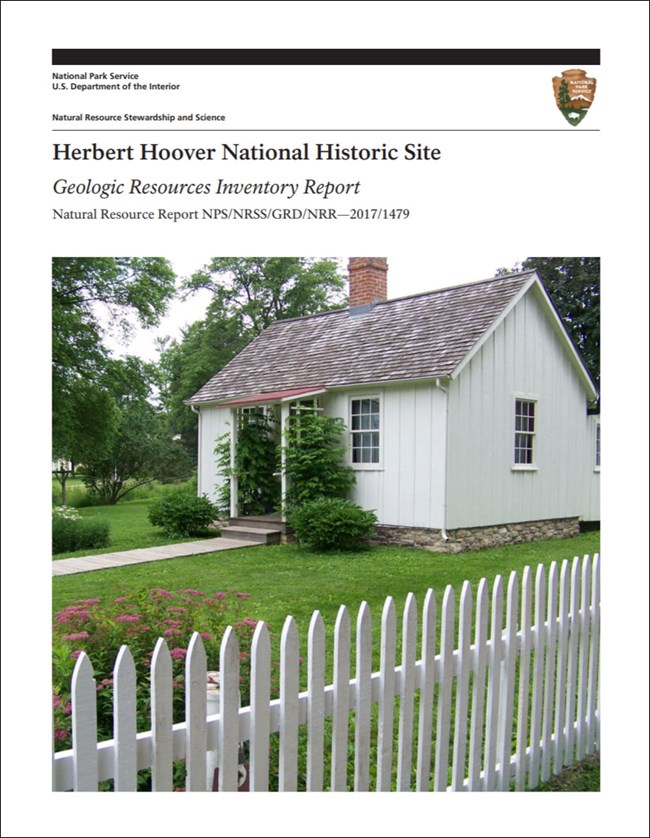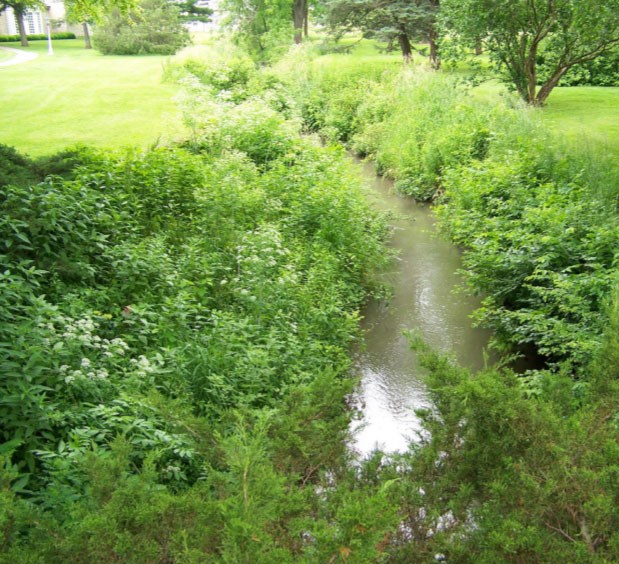Last updated: July 5, 2024
Article
NPS Geodiversity Atlas—Herbert Hoover National Historic Site, Iowa
Geodiversity refers to the full variety of natural geologic (rocks, minerals, sediments, fossils, landforms, and physical processes) and soil resources and processes that occur in the park. A product of the Geologic Resources Inventory, the NPS Geodiversity Atlas delivers information in support of education, Geoconservation, and integrated management of living (biotic) and non-living (abiotic) components of the ecosystem.

Introduction
Herbert Hoover National Historic Site (HEHO) is located approximately 14 km (9 mi) east of Iowa City in Cedar County, Iowa. Authorized on August 12, 1965, HEHO contains about 76 hectares (187 acres) and commemorates the life and accomplishments of the 31st United States president (1929–1933). The national historic site includes the cottage where Hoover was born, a blacksmith shop, the first West Branch schoolhouse, the Friends Meetinghouse where the Hoover family worshipped, the Hoover Presidential Library Museum, and the gravesites of President and First Lady Hoover (National Park Service 2016a). Herbert Hoover was an accomplished engineer, mining geologist, humanitarian, and United States president whose childhood was heavily influenced by the West Branch community and members of his family’s Quaker church. HEHO was designed with the direct involvement of Herbert Hoover, Lou Henry Hoover, their family, friends, and the local community of West Branch (National Park Service 2017a).
Geologic Setting
Situated near the northern boundary of the Southern Iowa Drift Plain, the landscape of Herbert Hoover National Historic Site consists of rolling hills and farms underlain by Paleozoic strata covered by a veneer of Quaternary surficial deposits (Quade et al. 2008). The bedrock of HEHO consists of fossiliferous sedimentary rocks of the Silurian and Devonian, including the Scotch Grove Formation, Gower Formation, and rocks associated with the Wapsipinicon Group. Deposition of these Paleozoic rocks occurred millions of years ago at a time when an ancient ocean inundated present-day Iowa (Graham 2017a). During the Pre-Illinoian glacial cycle ~2.6 to 0.5 Ma (Mega-annum, million years ago), glaciers advanced and retreated several times across the Southern Iowa Drift Plain, leaving behind young surficial deposits consisting of unconsolidated glacial till, loess, and alluvium (Mickelson and Colgan 2004; Quade et al. 2008; Bettis et al. 2010).
Regional Geology
Herbert Hoover National Historic Site is a part of the Central Lowland Physiographic Province and shares its geologic history and some characteristic geologic formations with a region that extends well beyond park boundaries.
- Scoping summaries are records of scoping meetings where NPS staff and local geologists determined the park’s geologic mapping plan and what content should be included in the report.
- Digital geologic maps include files for viewing in GIS software, a guide to using the data, and a document with ancillary map information. Newer products also include data viewable in Google Earth and online map services.
- Reports use the maps to discuss the park’s setting and significance, notable geologic features and processes, geologic resource management issues, and geologic history.
- Posters are a static view of the GIS data in PDF format. Newer posters include aerial imagery or shaded relief and other park information. They are also included with the reports.
- Projects list basic information about the program and all products available for a park.
Source: NPS DataStore Saved Search 2897. To search for additional information, visit the NPS DataStore.
A NPS Soil Resources Inventory project has been completed for Herbert Hoover National Historic Site and can be found on the NPS Data Store.
Source: NPS DataStore Saved Search 2968. To search for additional information, visit the NPS DataStore.
GRI Geology Image Gallery

Related Links
Related Articles
Herbert Hoover National Historic Site
National Park Service Geodiversity Atlas
The servicewide Geodiversity Atlas provides information on geoheritage and geodiversity resources and values within the National Park System. This information supports science-based geoconservation and interpretation in the NPS, as well as STEM education in schools, museums, and field camps. The NPS Geologic Resources Division and many parks work with National and International geoconservation communities to ensure that NPS abiotic resources are managed using the highest standards and best practices available.

